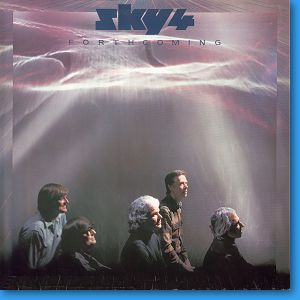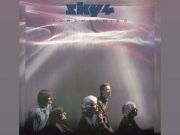
The Albums
The Singles
Compilations
The Band
The Gigs
The Story of Sky
Forum
Extras
Contact
Home
|
 |

Kevin Peek (Acoustic & Electric Guitars, Guitar Synths)
Tristan Fry (Drum Kit & Percussion, Waterphone)
Steve Gray (Keyboards)
Herbie Flowers (Electric & String Bass, Tuba)
John Williams (Acoustic & Electric Guitars)
Released: April 1982
Peak position in UK charts: 7 (April 1982)
Availability:
Sky 4 was released on CD at the time of release in Australia, and later in 1993 on the Music Club budget label in the UK, and with a different cover in Europe. It is hardly surprising that, 10 years later, it is now out of print and not available in shops. It is generally fairly easy to find on eBay even if listed as "rare".
In the meantime, click on the track title to hear/download an MP3 sample from the track (roughly one minute in all cases). I don't include the full tracks for a multitude of reasons, and never will.
Short Review:
It wasn't question of "if", but of "when" Sky would produce their first album consisting solely of "interpretations" of classical pieces. The best-known of the pieces, the Ride of the Valkyries, is in my estimation a total flop. OK, so the band insist it's a joke. Sorry, guys, but some jokes just aren't funny! And if you need to explain a joke, it's even worse. The only tracks on this album which work for me don't actually form part of the canon of Western classical music at all: "Z" (which John had already recorded twice during his career: once "straight", with Maria Farandouri providing vocals, and once with a more jazzy feel), Xango (not a great piece of music in the grand scheme of things, but pleasant nevertheless) and the final track, which I agree isn't what Sky should be about, but so what?
Agree? Disagree? Have your say in the Forum!
Track listing (including original liner notes from the band):
Masquerade (Khatchaturian, Arr. Gray)
Herbie: "Masquerade comes from "a real duff play called 'Maskerad' written by Lermontov in 1939. Luckily, the music was by Khatchaturian, a great
composer, and not only was it much better than the play, it also sounded good on guitars."
Steve: "It was Herbie who first hummed 'Masquerade' to us, but only Tristan could remember What it was called. In the end, I did the
arrangement, transposing the key and the approach to suit John's guitar better.
Ride of the Valkyries (Wagner, Arr. Gray)
Herbie: This is the daftest tune ever written. It always made us laugh, it's so simple in its musical construction. So we decided
to take the mickey and make it sound like a tinny little band struggling with this huge music. Then we got carried away, added loads of echo,
and fattened it up until the deejay Alan Freeman came by and pointed out that it sounded like a full-blown symphony, so we returned to the
original idea and mixed it back down. Unfortunately, reviewers didn't get the joke so this is probably the most misunderstood piece of Sky
music ever recorded.
March to the Scaffold (Berlioz, Arr. Fry)
Herbie: "I remember this as being John's idea. It's from the Symphonie Fantastique, which they call programme music, meaning that the music represents the action in a story".
Tristan (who arranged it): "There's a recurring melody throughout the symphony which depicts our hero's dream girl. In 'March To The Scaffold', that melody appears but is
quickly cut off when the hero's head is removed by the guillotine. Great stuff.
Better than watching TV."
To Yelasto Pedi (The
Smiling Boy) (Theodorakis, Arr. Williams)
John: "I had no hesitation in including this, by modern Greek composer Mikis Theodorakis alongside the
giants of the past. This is a setting of a verse from Brendan
Behan's drama 'The Hostage'. It was used as the theme for the film 'Z' and
has become one of his best-known melodies."
Herbie: "We always felt that a great tune was a great tune, no matter when it
was written or who wrote it. After all, how do you define classical music? Surely it's just music that will live on.'To Yelasto Pedi' has a wonderful complicated time signature, a dance rhythm that seems to come naturally to the Greeks, but it took a bit of work for us to get the hang of it."
Waltz No. 2 (Ravel, Arr. Gray)
Steve: "This, from Ravel's 'Valses Nobles et Sentimentales', gave
us problems of a different kind. I've always loved it, in its piano
form and in its orchestrated form, so I was keen that we should have a crack at
it. However, Ravel was alive in comparatively recent times, so the
work was still in copyright. I did the arrangement, we sent it off to Ravel's
estate for permission to use it, and they rejected it. In the end we wrote a grovelling letter, asking them to reconsider, which they kindly did, and we were able
to release it."
Herbie: "This is the most successful piece on the album. It's like a Japanese painting of a goldfish, where you just have a fish and a
blade of grass, but somehow you can see the rippling water and the lily pads and
everything. What's not there is as important as what is there."
Fantasy (Fantasia in C Minor) (Bach, Arr. Williams)
John: "One of my favourite records has always been the great Colombian harpsichordist Rafael Puyana playing Bach's 'C Minor Fantasy'. The strength and vitality of his playing is wonderful. But we're louder."
Herbie: "What intrigues me about this is that Bach is, as near as dammit, just
like synthesizer music. It has its own strict mathematical
progression, and yet the two things are separated by hundreds of years."
My Giselle (Peek, from de la Halle)
Kevin: "I found 'My Giselle' in a classical guitar book bought years ago. The actual melody, written by Adam De La Halle, is a haunting little thing which occupies only the first eight bars or so of our version. The remainder is an extension and re-working of ideas on his theme."
Herbie: "I seem to recall that Kevin had a new guitar synth which he was keen
to use and this tune was perfect for it. Unfortunately, the guitar-synth was very unreliable and I don't think we ever used it again."
Xango (Villa Lobos, Arr. Sky)
Herbie: "This traditional Brazilian tune was brought to public notice in
an arrangement by Hector Villa-Lobos. It's a bit like a Brazilian version of
Ravel's 'Bolero'. We decided it was like a procession, starting with Kev playing a rhythm on electric guitar, followed the
melody on the marimba. Then, one by one, everybody else has a turn at the melody while the marimba changes to a counter-rhythm. At the end, the procession disappears into the undergrowth to play another game of Scrabble."
Fantasia (Mudarra, Arr. Peek/Flowers)
Kevin: "Spanish composer Alonso de Mudarra wrote his 'Fantasia' in the 16th century for the vihuela, an early forerunner of the Spanish guitar. I had been playing it for years and I thought it sounded more like a modern pop tune than a genuine 16th century composition. One thing I
love about it is that on the second page of the score, under a quite dissonant ascending bass-line, there's an apology from Mudarra saying that if you play it fast enough and confidently enough, it won't sound wrong."
Skylark (Carmicheal/Mercer Arr. Gray/Williams)
Steve: "Given that the Greek Theodorakis and the Brazilian Villa-Lobos had, by this point, been thoroughly integrated into what was planned as a
purely European classical album, I felt no compunction about suggesting 'Skylark' by the American songwriter Hoagy Carmichael. I was round at John's house in Hampstead one day and I remembered it, so I started playing it on the piano. John had never heard the song
before, but he loved it and said we must do it. Sadly, Hoagy Carmichael died shortly after we had finished this track, which upset me at the
time. Then, in the studio, one of our producers said he didn't think it was a Sky kind of thing. The lads just yelled back 'Of course it's
Sky. We're playing it.' So there it is."
By popular demand, you can download a high-resolution scan of the record cover sized for use as your computer desktop picture.
Click on the resolution which your computer uses for the right size. If you're using MSIE or Netscape as your browser, right-click on the picture when it comes up and select "Set as Wallpaper".

1024x768
800x600
640x480
|
 |







